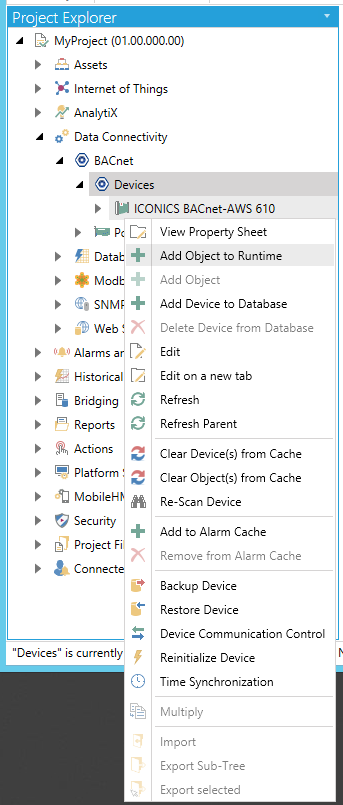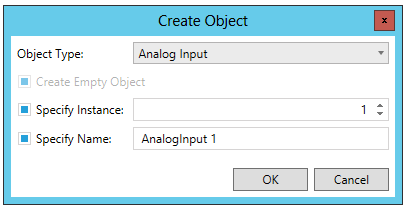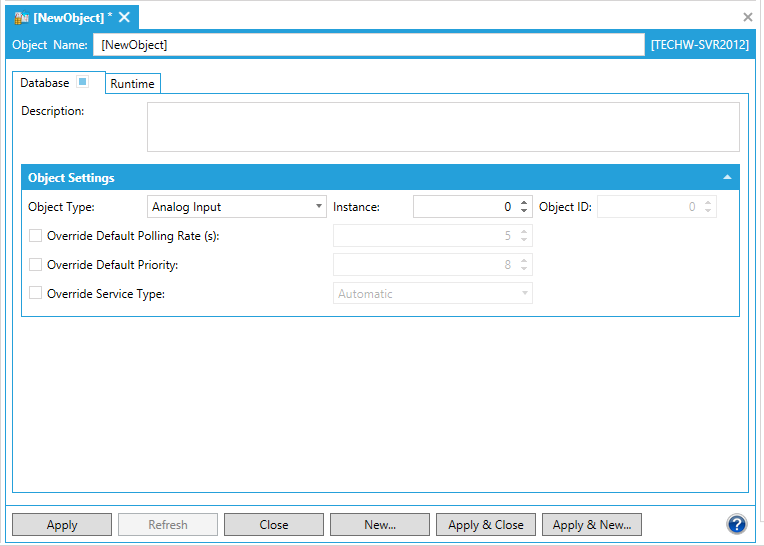|
|
The features on this page require an add-on to work with GENESIS64 Basic SCADA. |
|
|
The features on this page require an add-on to work with GENESIS64 Basic SCADA. |
BACnet utilizes "objects" to represent either physical items or descriptions of processes/calculations/operations. There are multiple object "types", each with a list of required and optional properties. These include:
|
Value |
Object Type |
|
Value |
Object Type |
|
0 |
analog-input |
|
31 |
timer |
|
1 |
analog-output |
|
32 |
access-credential |
|
2 |
analog-value |
|
33 |
access-point |
|
3 |
binary-input |
|
34 |
access-rights |
|
4 |
binary-output |
|
35 |
access-user |
|
5 |
binary-value |
|
36 |
access-zone |
|
6 |
calendar |
|
37 |
credential-data-input |
|
7 |
command |
|
38 |
network-security |
|
8 |
device |
|
39 |
bitstring-value |
|
9 |
event-enrollment |
|
40 |
characterstring-value |
|
10 |
file |
|
41 |
date-pattern-value |
|
11 |
group |
|
42 |
date-value |
|
12 |
loop |
|
43 |
datetime-pattern-value |
|
13 |
multi-state-input |
|
44 |
datetime-value |
|
14 |
multi-state-output |
|
45 |
integer-value |
|
15 |
notification-class |
|
46 |
large-analog-value |
|
16 |
program |
|
47 |
octetstring-value |
|
17 |
schedule |
|
48 |
positive-integer-value |
|
18 |
averaging |
|
49 |
time-pattern-value |
|
19 |
multi-state-value |
|
50 |
time-value |
|
20 |
trend-log |
|
51 |
notification-forwarder |
|
21 |
life-safety-point |
|
52 |
alert-enrollment |
|
22 |
life-safety-zone |
|
53 |
channel |
|
23 |
accumulator |
|
54 |
ligthing-output |
|
24 |
pulse-converter |
|
55 |
binary-lighting-output |
|
25 |
event-log |
|
56 |
network-port |
|
26 |
global-group |
|
57 |
elevator-group |
|
27 |
trend-log-multiple |
|
58 |
escalator |
|
28 |
load-control |
|
59 |
lift |
|
29 |
structured-view |
|
|
|
|
30 |
access-door |
|
|
|
To Create a New BACnet Object:
From the Workbench, expand your Project in the Project Explorer, then expand Data Connectivity.
You'll see the BACnet node of the Project Explorer, as shown below.
BACnet Provider in the Workbench

Expand the BACnet node, then expand the Devices branch, then select the Device to which you would like to add an Object, then and click on Add Object to Runtime, as shown below.
Add Object to Runtime from Project Explorer

-OR-
Select the Device to which you would like to add an Object, then click on the Add Object to Runtime button, shown below, in the Edit section of the Home ribbon in the Workbench.
Add Object to Runtime Button

A Create Object window may open, requesting you to select the type of object you'd like to create, as well as create an empty object, specify an instance and/or specify a name. If this occurs, make your selections, then click OK.
Create Object Window

If not, the Object properties will display.
BACnet Object

Type a name in the Object Name textbox.
Enter a Description in the text entry field.
Object Settings
Specify the Object Type in the dropdown menu (Analog Input by default) and specify the right Instance # (usually 1). The Object ID should be generated automatically.
The following Object Settings may be changed:
Object Type – Using the pulldown menu, choose from one of the following object types:
Access Credential
Access Door
Access Point
Access Rights
Access User
Access Zone
Accumulator
Alert Enrollment
Analog Input
Analog Output
Analog Value
Averaging
Binary Input
Binary Lighting Output
Binary Output
Binary Value
BitString Value
Calendar
Channel
Character String Value
Command
Credential Data Input
Date Pattern Value
Date Time Pattern Value
Date Time Value
Date Value
Device
Elevator Group
Escalator
Event Enrollment
Event Log
File
Global Group
Group
Integer Value
Large Analog Value
Life Safety Point
Life Safety Zone
Lift
Lighting Output
Load Control
Loop
Multistate Input
Multistate Output
Multistate Value
Network Port
Network Security
Notification Class
Notification Forwarder
Octet String Value
Positive Integer Value
Program
Pulse Converter
Schedule
Structured View
Time Pattern Value
Timer
Time Value
Trend Log
Trend Log Multiple
The following properties are common to many of the object types.
Instance - An Object's Instance number identifies it within a BACnet Device. In combination with the selected Object Type, the number entered here will then determine the Object ID (see below) in the field to the right.
Object ID – Objects on an interconnected BACnet/IP network should have unique numbers to quickly identify them and prevent possible confusion.
Override Default Polling Rate (s) – Sets the frequency of communication between BACnet objects and the BACnet Connector. Range can be between 0 and 4194303.
Override Default Priority – Sets a number between 1 and 16 as to the criticality of an object, in comparison with others. Assigning a priority level marks the importance of messages and which will override others. Some numbers are pre-assigned (1, 2, 5, 6, 8), with life safety naturally having highest priority. Other numbers (3, 4, 7 and 9 through 16) are not assigned and therefore are available for users to set their own priorities. Default is 8.
Override Service Type – BACnet service type to be used for data reading.
The Runtime tab of the Object properties provides multiple additional properties that can be configured via either the Group or List tab. The following descriptions are from the Group tab, but each individual property can also be found via the List tab, as well.
Basic/Object
Description -Description of the object. Enter a description in the text entry field.
Object Type -Type of object. Use the pulldown menu to select from listed types.
Object List -Object list property of the device. Click on the ellipsis button [...] to open the Collection window.
BACnet/BACnet
Local Device ID -Enter a local device ID in the text entry field or use the up/down arrow buttons.
Object Identifier -
Profile Name -
Property List -
Protocol Version -
Protocol Revision -
Align Intervals -
Protocol Ser Support -
Device Scan Enable -
Protocol Obj Support -
Device Scan Status -
Interval Offset -
Time Synchronization Interval -
UTC Time Synchronization Recipients -
Last Restart Reason -
Restart Notification Recipients -
Connect Strings -
Router To Network Address Binding -
Time Of Device Restart -
Basic/Device
Vendor Name -
Vendor Identifier -
Model Name -
Firmware Revision -
Application Software Version -
Database Revision -
Location -
Basic/Status
System Status -
Basic/Time
Local Time -
Local Date -
Daylight Savings Status -
Time Synchronization Recipients -
UTC Offset -
Advanced/Network
Segmentation -
Max Segments Accepted -
ADPU Timeout -
Max APDU Length Accepted -
ADPU Segment Timeout -
Number of ADPU Retries -
Max Info Frames -
Max Master -
Advanced/Advanced Setup
VT Classes Supported -
Active VT Sessions -
List of Session Keys -
Device Addr Binding -
Configuration Files -
Last Restore Time -
Backup Fail Timeout -
Active COV Subscriptions -
Click Apply to proceed.
See also: